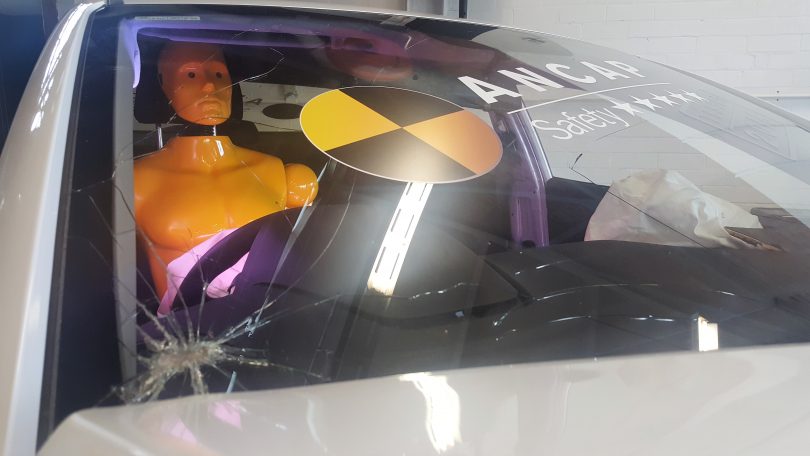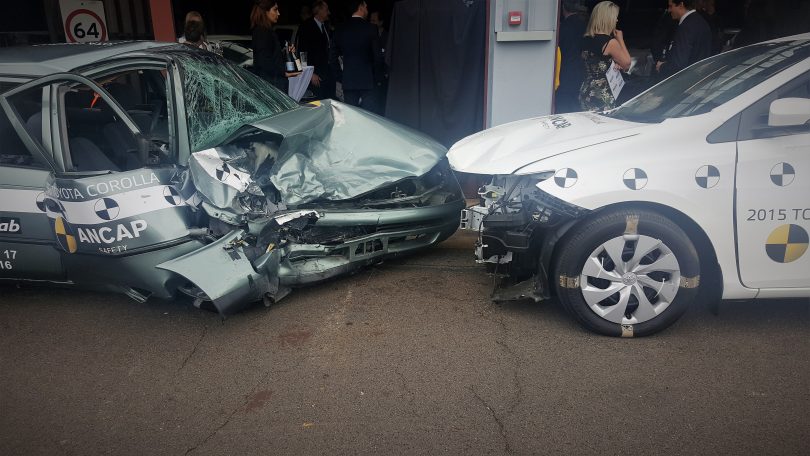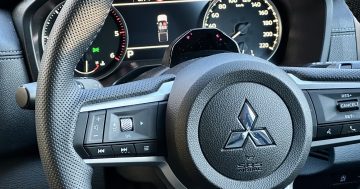
I don’t like to judge, but this guy in yellow seems to be a *terrible* driver … Photos: Jane Speechley.
It was around this time last year that I wrote this piece on motor vehicle safety.
Coming into the festive season, I wanted to explore how and why we continue to die on our roads despite the fact that our roads, cars, and safety awareness are better than ever.
So it’s timely that, earlier this month, I had the privilege of attending the ANCAP safety authority end-of-year celebration.
ANCAP stands for ‘Australasian New Car Assessment Program’ and they’re the leading safety advocate for motor vehicles in Australia.
You’ll probably recognise the name, even if you don’t know the organisation well. They’re the ones that deliver that ‘5-star ANCAP safety rating’ that you’re used to hearing from manufacturers in their advertising.
What I didn’t know, is that the ANCAP head office and national storage warehouse is located right here in Canberra.
All the testing of vehicles is done in Sydney, Melbourne and Adelaide – with different sites to run different kinds of tests – but once the vehicles have been thoroughly ‘tested’ (i.e., smashed to within an inch of their lives), their remains are stored here in Canberra.
Where, ideally, they’ll actually spend very little time sitting in the warehouse, and much more time out helping to educate the community.
For example, the two Corollas that starred in their most popular ever YouTube video (here) were recently on display in the city centre; while Lennock Hyundai was happy to show off what remained of an Elantra as a testament to its excellent performance in the test.

The 2015 Toyota Corolla was the clear winner in this battle.

Paintwork is a bit of a mess, but the occupants of this Hyundai Elantra would be very safe.
The warehouse is an interesting, if rather unusual, environment for a celebration – enjoying drinks and nibbles while you stroll among cars that look like they’ve been in terrible and tragic accidents. Indeed, the ANCAP team say you never quite get used to the sound and spectacle of the cars crashing – even when it’s deliberate and expected, it’s always unsettling.
Here are a few other interesting tidbits I found out, at the event.
ANCAP isn’t a government agency
Established in 1993, ANCAP works closely with the various national and state/territory automobile clubs, but they’re a not-for-profit organisation and not a government body.
They’re fully independent and governed by a Board of Directors. The national office is actually a very small team of 8 people, based here in Canberra.
Vehicle manufacturers are rarely surprised by their results – even if they pretend to be
Manufacturer representatives are always invited along to observe the testing.
But the – quite reassuring – truth is that motor vehicle companies now spend so much time and money developing and testing their own safety features, that the results of their ANCAP testing are rarely any surprise to them at all.
Chinese-made vehicles are getting better
In the past, vehicles made in China have not performed well in safety testing – in fact, they’ve generally dominated the poorest performing vehicles category.

What happens when a Chery J1 meets a block at 64kmph.
However, for the first time in 2017, a Chinese designed and manufactured vehicle (the MG GS) was awarded the 5-star rating in September.
Since then, several more have made the grade.
Structurally, cars are about as safe as they’re going to get
In my previous piece, I wrote about the difference between passive and active safety features.
In the past, it is the structural and passive safety features (air bags, seat belts, etc) where ANCAP has focused its attention.
But as our motor vehicles evolve, so does ANCAP’s approach. The real area for progress now is in the active safety features.
And in fact, changes in the ANCAP safety rating system designed to keep up with this technology will mean that from 2018 onwards, it will be impossible for a vehicle without the full suite of active safety features to secure a 5-star rating.
From 2018, ANCAP is raising the bar
ANCAP now rates about 92% of new vehicles, and of those, around 88% get a 5-star rating. By their own estimations, that means it’s time to lift the benchmark, so consumers can continue to see incremental improvements in vehicle safety.
From next year, vehicles will be measured against four key pillars: adult occupant protection, child occupant protection (added as a separate category for the first time), pedestrian protection, and safety assist.
The rating will also be accompanied by a date stamp. This will show you not only how current the safety rating is, but – given the evolving testing regime – which standard it was tested against. You should look for a date less than 3 years ago, and the ‘use by’ date will effectively be 6 years.
The message from ANCAP is simple: buy a car with the maximum 5-star safety rating, and with the most recent date stamp that you can afford.
The organisation is making some practical and operational changes as well. For example, the weight of the block used in side-impact testing is being increased from 900kg to 1300kg, to reflect the reality that we’re all driving (and therefore, are likely to be struck by) larger, heavier vehicles.
Following a long process of collaboration, ANCAP standards will now also be aligned with its Euro NCAP counterpart. This is the first time this has happened, so they’re the first organisation of their kind to achieve international consistency.
And finally – like many of us – the ANCAP team is already considering how it will deal with the challenges presented by more radical technological shifts, especially autonomous/self-driving cars.
So how are we doing this year, Canberra drivers?
I almost don’t want to mention, for fear of ‘jinxing’ it – but if we can all just stay safe on the roads for the next few weeks, the ACT will record it’s lowest annual road toll since 2011, and the equal lowest since 2000.
With a current toll of six fatalities, that’s down from 10 in 2016 and 15 in 2015.
This issue has been particularly on my mind especially this week, as we at The RiotACT have been doing what we can to help raise awareness and support for TJ Campagna, the 13-year-old boy injured in this horror smash on the King’s Highway last week.
It’s a timely reminder that while these statistics focus on those who have died, those who survive serious accidents and their loved ones face a long and difficult road to recovery. Last year, the ACT reportedly had the highest rate of hospital visits for car accidents, despite our (relatively) lower road toll compared to other states.
So we’re still having plenty of accidents – they’re just slightly less serious.
Stay safe out there.
What’s your message to people on our roads this Christmas? If you could tell travellers just one thing, what would it be? Share them with us in the comments section below.





















